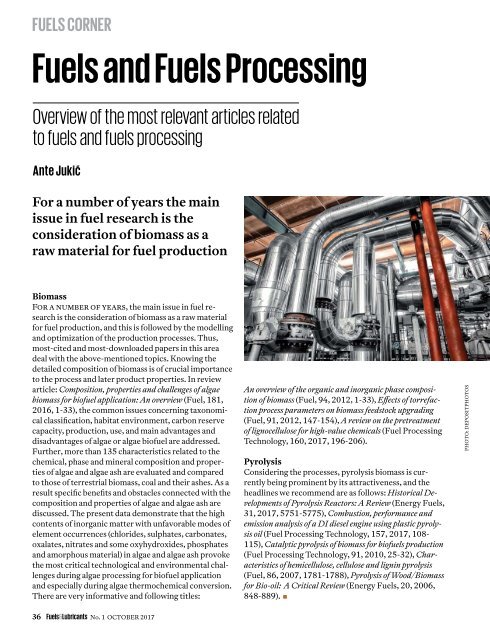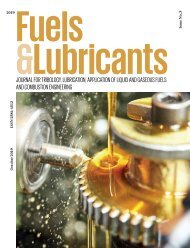Fuels & Lubricants Magazine
Issue 1, October 2017
Issue 1, October 2017
Create successful ePaper yourself
Turn your PDF publications into a flip-book with our unique Google optimized e-Paper software.
<strong>Fuels</strong> Corner<br />
<strong>Fuels</strong> and <strong>Fuels</strong> Processing<br />
Overview of the most relevant articles related<br />
to fuels and fuels processing<br />
Ante Jukić<br />
For a number of years the main<br />
issue in fuel research is the<br />
consideration of biomass as a<br />
raw material for fuel production<br />
Biomass<br />
For a number of years, the main issue in fuel research<br />
is the consideration of biomass as a raw material<br />
for fuel production, and this is followed by the modelling<br />
and optimization of the production processes. Thus,<br />
most-cited and most-downloaded papers in this area<br />
deal with the above-mentioned topics. Knowing the<br />
detailed composition of biomass is of crucial importance<br />
to the process and later product properties. In review<br />
article: Composition, properties and challenges of algae<br />
biomass for biofuel application: An overview (Fuel, 181,<br />
2016, 1-33), the common issues concerning taxonomical<br />
classification, habitat environment, carbon reserve<br />
capacity, production, use, and main advantages and<br />
disadvantages of algae or algae biofuel are addressed.<br />
Further, more than 135 characteristics related to the<br />
chemical, phase and mineral composition and properties<br />
of algae and algae ash are evaluated and compared<br />
to those of terrestrial biomass, coal and their ashes. As a<br />
result specific benefits and obstacles connected with the<br />
composition and properties of algae and algae ash are<br />
discussed. The present data demonstrate that the high<br />
contents of inorganic matter with unfavorable modes of<br />
element occurrences (chlorides, sulphates, carbonates,<br />
oxalates, nitrates and some oxyhydroxides, phosphates<br />
and amorphous material) in algae and algae ash provoke<br />
the most critical technological and environmental challenges<br />
during algae processing for biofuel application<br />
and especially during algae thermochemical conversion.<br />
There are very informative and following titles:<br />
An overview of the organic and inorganic phase composition<br />
of biomass (Fuel, 94, 2012, 1-33), Effects of torrefaction<br />
process parameters on biomass feedstock upgrading<br />
(Fuel, 91, 2012, 147-154), A review on the pretreatment<br />
of lignocellulose for high-value chemicals (Fuel Processing<br />
Technology, 160, 2017, 196-206).<br />
Pyrolysis<br />
Considering the processes, pyrolysis biomass is currently<br />
being prominent by its attractiveness, and the<br />
headlines we recommend are as follows: Historical Developments<br />
of Pyrolysis Reactors: A Review (Energy <strong>Fuels</strong>,<br />
31, 2017, 5751-5775), Combustion, performance and<br />
emission analysis of a DI diesel engine using plastic pyrolysis<br />
oil (Fuel Processing Technology, 157, 2017, 108-<br />
115), Catalytic pyrolysis of biomass for biofuels production<br />
(Fuel Processing Technology, 91, 2010, 25-32), Characteristics<br />
of hemicellulose, cellulose and lignin pyrolysis<br />
(Fuel, 86, 2007, 1781-1788), Pyrolysis of Wood/Biomass<br />
for Bio-oil: A Critical Review (Energy <strong>Fuels</strong>, 20, 2006,<br />
848-889).







